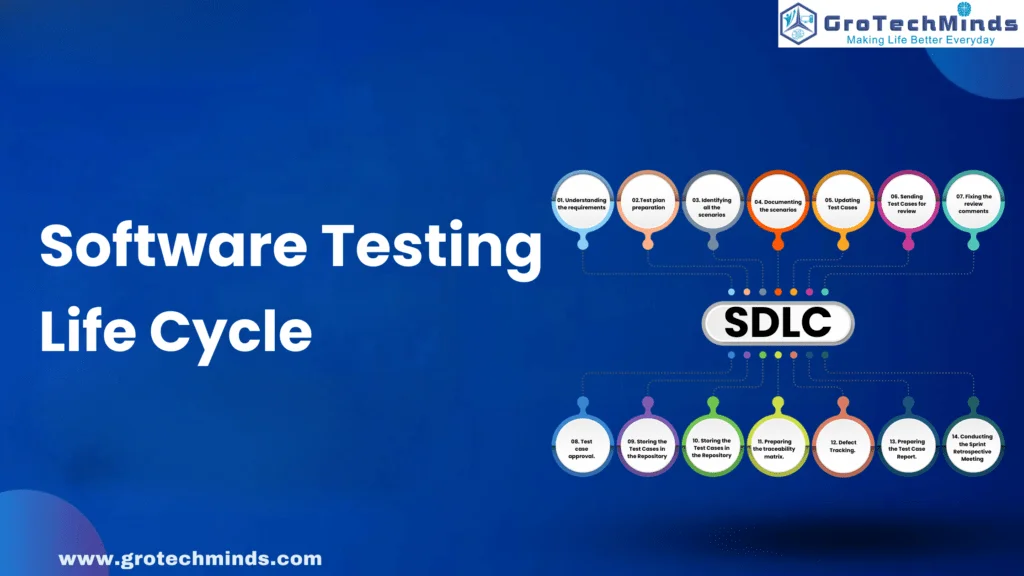

Unlocking Quality: Exploring the Software Testing Life Cycle
STLC is expanded as Software Testing Life Cycle or Software Test Life Cycle. Every software development organization has its testing methodology, which is the strategies and the types of testing used to certify that the Application Under Test (AUT) meets the client’s expectations. Even though there is a variation in the testing methodology between any two organizations, depending on what works and what doesn’t, a form of STLC is always present.
STLC is usually performed whenever a new feature is being added to the build. The software testing life cycle is the phases of the testing process during software development. Each step has clear goals, actions, and deliverables that serve as the input to the next stage. Those stages are given as,
- Understanding the requirements.
- Test plan preparation.
- Identifying all the scenarios.
- Documenting the scenarios.
- Updating Test Cases.
- Sending Test Cases for review.
- Fixing the review comments.
- Test case approval.
- Storing the Test Cases in the Repository.
- Preparing the traceability matrix.
- Executing the Test Cases.
- Defect Tracking.
- Preparing the Test Case Report.
14. Conducting the Sprint Retrospective Meeting.
As a tester, we are usually handed a document filled with technical jargon that sounds like it was written by robots. That is the requirement document, and understanding it is our first mission. This phase is all about getting on the same page as the developers. Here, testers clarify questions such as, what features are they building? What are the user expectations? etc.,
The test plan is our battle plan, outlining what we’ll test, how we’ll test it, and what resources we’ll need. We outline the scope and approach of our testing efforts. It not only defines what aspects of the software we’ll test but also how we’ll conduct those tests and what resources we’ll require for execution. This document acts as a guiding beacon, ensuring alignment and cohesion across the testing team while maximizing efficiency and effectiveness in our testing endeavors.
This is where we put on our creative thinking cap and imagine every possible way a user might engage with the software, from the straightforward to the unexpected. By immersing ourselves in the user’s perspective, we uncover potential pathways that may lead to software success or failure. Through exhaustive scenario identification, we equip ourselves with a comprehensive understanding of the software’s functionality and user experience, laying the groundwork for robust testing strategies. We also use different design techniques like BVA(Boundary Value analysis), ECP(Equivalence Class partitioning), etc., to ensure maximum coverage.
These test scenarios need to be documented for future reference. This phase involves translating our brainstorming session into a clear and concise format. Documenting these scenarios is crucial. We are outlining every possible way a user might navigate the app including the positive and negative scenarios. This ensures everyone on the team understands how these scenarios will be tested.
Now that we have our documented test scenarios, it’s time to create the actual test cases. These are the detailed instructions we’ll follow to test each functionality. Here’s where we get to refine it with our testing skills, ensuring our test cases are clear and concise, covering all the important aspects of each scenario, and we decide on how to avoid doing overtesting. The test cases are written in a test case template that is more or less universal across the software testing landscape.
This stage involves sharing our carefully crafted test cases with the team(peers) for review. Their feedback helps to ensure your test cases are comprehensive and effective. By subjecting our test cases to the discerning eyes of our peers, we invite constructive feedback and insights that serve to enhance the comprehensiveness and effectiveness of our testing strategy.
Upon receiving feedback from our peers during the review phase, we enter the critical stage of addressing and implementing the suggested changes. This phase involves carefully analyzing the review comments, identifying areas for improvement, and incorporating necessary revisions into our test cases. It entails revisiting our test cases with a critical eye, ensuring that each comment is thoroughly understood and addressed. Whether it involves clarifying ambiguous steps, correcting inaccuracies, or enhancing test coverage, every modification is aimed at enhancing the quality and effectiveness of our testing efforts.
Test case approval serves as a crucial checkpoint in the testing process, signifying the culmination of our efforts to craft comprehensive and effective testing strategies. Upon approval, test cases are deemed ready for execution, signaling the green light for testing activities to proceed. All the test cases are frozen after the test cases have been approved.
The test case repository is a digital vault for all our test cases. Moreover, the repository serves as a living archive, constantly evolving and adapting to meet the changing needs of our testing initiatives. As new test cases are added and existing ones are refined, the repository grows in richness and depth, becoming an indispensable resource in our quest for software excellence.
The preparation of the traceability matrix emerges as a crucial phase in our journey towards software excellence. The traceability matrix serves as a vital navigational tool, guiding us through the maze of requirements and test cases, and establishing clear connections between them. We meticulously map each test case to the specific requirements it validates, forging a web of interconnectivity that ensures comprehensive test coverage and alignment with project objectives.
This stage represents the culmination of our testing efforts, as we put our meticulously crafted test scenarios into action, rigorously validating the functionality and performance of the software under test. Executing the test cases involves a systematic and methodical approach, as we follow the steps outlined in each test case, verifying the behavior of the software against expected outcomes. With precision and attention to detail, we navigate through the user journeys and interaction scenarios, probing for any deviations from the desired functionality.
When you encounter a bug during test execution, this phase is all about capturing it effectively. During this phase, defects encountered during test execution are meticulously documented and prioritized based on severity. Each defect undergoes thorough analysis and resolution in collaboration with development teams. Through proactive defect management, software integrity and reliability are upheld, ensuring it meets the highest quality standards.
The test case report summarizes the tests you executed, the bugs you found, and the overall health of the application. It’s like a post-game report, analyzing your performance and highlighting areas for improvement. In this stage, the findings from test execution are summarized and documented. The Stakeholders gain insights into test coverage and performance, for an informed decision-making process. The report serves as a valuable artifact for assessing testing outcomes and guiding future testing efforts.
The final phase of the STLC is all about reflection and improvement. The sprint retrospective meeting is a chance for the entire testing team to gather and discuss the past testing cycle. The questions that are entertained in the Sprint Retrospective Meeting are like, What went well? What could be improved? Did you encounter any unexpected challenges? etc., Here, the lessons learned are identified, opportunities for improvement are explored, and the retrospective meeting fosters a culture of continuous learning and adaptation within the team. Insights gained inform future testing strategies, enhancing efficiency and effectiveness. After all, a good tester is always learning and evolving.
Also read : Types of software testing
The STLC is a flexible framework, and the specific steps might vary depending on the project and methodology. But with these core stages as our guide, we’ll be well on our way to conquering the world of software testing! As we navigate the dynamic landscape of software testing, let us remain agile in our methods and steadfast in our commitment to delivering quality solutions.
Also,understanding the Software Testing Life Cycle is crucial for ensuring the quality and reliability of software products. By following the sequential phases of planning, designing, executing, and reporting, software testing teams can effectively identify and mitigate any potential issues early on in the development process. With proper execution of the STLC, organizations can save time and resources while delivering high-quality software that meets user expectations. We hope this article has provided you with valuable insights and practical tips to enhance your software testing skills check out our Test Automation Course . Stay informed, stay diligent, and continue striving for excellence in software quality assurance.
Consult Us


















